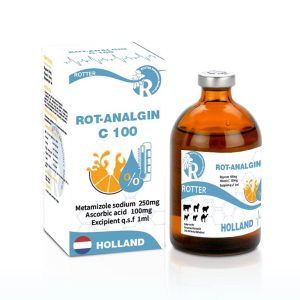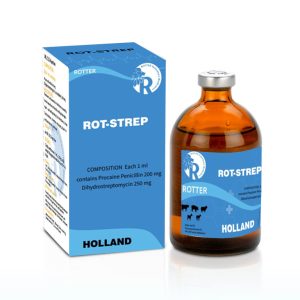
Rotflor-300
Contains per ml:
Florfenicol…………………300 mg.
Solvents ad ……………….1 ml.
Rotflor-300 is indicated for preventive and therapeutic treatment of respiratory tract infections in cattle due to
Mannheimia haemolytica, Pasteurella multocida and Histophilus somni. The presence of the disease in the herd should
be established before preventive treatment. It is additionally indicated for treatment of acute outbreaks of respiratory
disease in pigs caused by strains of Actinobacillus pleuropneumoniae and Pasteurella multocida susceptible to
florfenicol.
Florfenicol is a synthetic broad-spectrum antibiotic effective against most Gram-positive and Gram-negative
bacteria isolated from domestic animals. Florfenicol acts by inhibiting protein synthesis at the ribosomal level and
is bacteriostatic. Laboratory tests have shown that florfenicol is active against the most commonly isolated bacterial
pathogens involved in bovine respiratory disease which include Mannheimia haemolytica, Pasteurella multocida,
Histophilus somni and Arcanobacterium pyogenes, and against the bacterial pathogens most commonly isolated in
respiratory diseases in pigs, including Actinobacillus pleuropneumoniae and Pasteurella multocida.
Not for use in cattle producing milk for human consumption.
Not to be used in adult bulls or boars intended for breeding purposes.
Do not administer in cases of previous allergic reactions to florfenicol.
For subcutaneous or intramuscular injection.
Cattle:
Treatment (IM): 1 ml per 15 kg body weight, twice at a 48-h interval.
Treatment (SC): 2 ml per 15 kg body weight, administered once.
Prevention (SC): 2 ml per 15 kg body weight, administered once.
The injection should only be given in the neck. The dose should not exceed 10 ml per injection site.
Swine: 1 ml per 20 kg body weight (IM), twice at a 48-hour interval.
The injection should only be given in the neck. The dose should not exceed 3 ml per injection site.
Note: Introflor-300 is not for use in cattle producing milk for human consumption.
– For meat:
Cattle: 30 days (IM route).
44 days (SC route).
Swine: 18 days.
The treated animals recover quickly and completely upon termination of treatment. Administration of the product by the
intramuscular and subcutaneous routes may cause inflammatory lesions at injection site which persist for 14 days.
In swine, commonly observed adverse effects are transient diarrhoea and/or peri-anal and rectal erythema/oedema
which may affect 50% of the animals. These effects can be observed for one week. Transient swelling lasting up to 5
days may be observed at the site of injection. Inflammatory lesions at the injection site may be seen up to 28 days.



